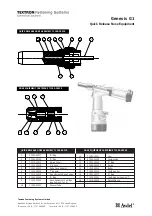
ii
2. Wiring
Title: (Danger.eps)
Creator: Adobe Illustrator(TM) 7.0
CreationDate: (1/26/0) (5:10 PM)
DANGER
l
Always connect the grounding wire to the dynamic braking unit to prevent electric
shock or fire.
(See page 3.)
l
All wiring should be done by a qualified electrician or electric shock or fire may occur.
(See page 3.)
l
Before wiring, make sure the supply power is off (or the P-N voltage is 45 V or less) to
prevent electric shock or fire.
(See page 3.)
l
Always install the dynamic braking unit on the wall before wiring to prevent electric
shock and personal injury.
(See page 3.)
l
Be sure to provide a thermal relay and a circuit, which shuts off primary power to the
inverter. This is to prevent burning-out the external resistor due to overheating if the
dynamic braking unit malfunctions.
(See page 3.)
For actual connections, see 4.3 and 4.4.
(See page 3.)
Title: (Triangle.eps)
Creator: Adobe Illustrator(TM) 5.5
CreationDate: (98.4.21) (9:42)
CAUTION
l
Make sure the voltage rating of the dynamic braking unit is equal to that of the inverter
to prevent fire and personal injury.
(See page 3.)
l
Do not connect resistors directly to the D.C. terminals (P and N) or fire may occur.
(See page 3.)
l
Tighten screws at their correct specified torque (see table on right). Make sure every
screw is firmly tightened or fire may occur.
(See page 3.)
l
The power cables should be MLFC flame-retardant poly-flex wire, allowing a voltage
of 600 V and capable of the specified amperage or fire may occur.
(See page 3.)






































